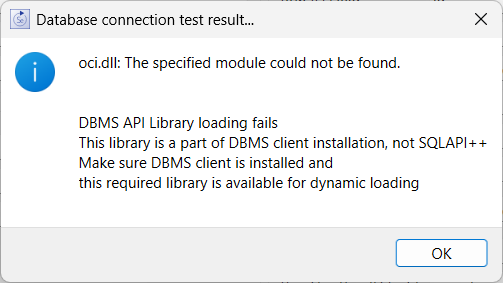
In order to use a database to store and retrieve data when using Stella Enterprise Desktop you will need to have the client side support for the database installed. Often this is done by simply installing the complete database as this will install both the server and client portions.
The critical thing from Stella's perspective, is to be able to find the supporting client side software. For example, if you try to connect to a database type that does not have the software installed you will (when clicking test connection in ImEx Database Connection Dialog) get a message like:

This message is from attempting connection to an Oracle database on Windows. The name of the file that can't be found will be different for different databases and different operating systems.
Resolving this is different on the different operating systems.
Typically, when you install a database installation will add the path to the system path and the supporting dlls (oci.dll) in the above case, will be available in that path.
If you can find the .dll file named in the message you will need to add its location to the path. If you can't find the .dll file names, but there is another with a similar name that supports the intended platform making a copy of that file to the name appearing in the test response may work. Moving the .dll to a location already in the path may also work, but may require moving more than one file.
The Macintosh uses a library search path to look for .dylib files, and installations on the Mac do not always add the software to that path. Rather than updating the global search path, it is more convenient to add symbolic links. Stella will look in /usr/local/lib when trying to find .dylib files. You should be able to add symbolic links to this directory with issue.
To install the client software Homebrew, a package management tool for the Macintosh, it likely the easiest way to do so. You can easily install both PostGreSQL and MySQL this way.
SQLServer uses ODBC to communicate. This is built into Windows, but not the Macintosh. To install using Homebrew (again in a terminal) first update the source for the specialized drivers:
brew tap microsoft/mssql-release https://github.com/Microsoft/homebrew-mssql-release
brew update
Then install them
brew install msodbcsql18 mssql-tools18
You can install different versions of the drivers. You may need to create a symbolic link to the name that Stella is looking for.
Most database clients can be installed with the native Linux package managers. When installed, they will add the .so files to the library search path. You may need to create a symbolic link if the file names differ somewhat from those expected by Stella.
When setting up Stella Server Enterprise you will need to make changes toe steam-server.conf to provide the database credentials. This content takes the form:
[ImExDB]
Microsoft%20SQL%20Server-stella\pwd=plaintextpassword
Microsoft%20SQL%20Server-stella\username=username
Microsoft%20SQL%20Server-stella\db_server="tcp:192.168.168.201,1433"
Microsoft%20SQL%20Server-stella\db_extra="TrustServerCertificate=YES"
PostgreSQL-stella\db_server=localhost
PostgreSQL-stella\username=username
PostgreSQL-stella\pwd=plaintextpassword
PostgreSQL-stella\db_server="192.168.168.222,5432"
PostgreSQL-stella\db_extra=
Note the use of %20 for a space - standard URL style encoding is used. The same for the content after the = which is enclosed in quotes if it uses any non alphanumeric character. What follows the = can always be quoted, but it is not necessary for just letters and numbers with no spaces.
For the above username and password are required. db_server and db_extra from the model will be used if they are not specified, but these may be different depending on the database configuration. Any other settings will be ignored.